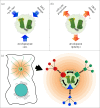Centrosomes as signalling centres
- PMID: 25047618
- PMCID: PMC4113108
- DOI: 10.1098/rstb.2013.0464
Centrosomes as signalling centres
Abstract
Centrosomes-as well as the related spindle pole bodies (SPBs) of yeast-have been extensively studied from the perspective of their microtubule-organizing roles. Moreover, the biogenesis and duplication of these organelles have been the subject of much attention, and the importance of centrosomes and the centriole-ciliary apparatus for human disease is well recognized. Much less developed is our understanding of another facet of centrosomes and SPBs, namely their possible role as signalling centres. Yet, many signalling components, including kinases and phosphatases, have been associated with centrosomes and spindle poles, giving rise to the hypothesis that these organelles might serve as hubs for the integration and coordination of signalling pathways. In this review, we discuss a number of selected studies that bear on this notion. We cover different processes (cell cycle control, development, DNA damage response) and organisms (yeast, invertebrates and vertebrates), but have made no attempt to be comprehensive. This field is still young and although the concept of centrosomes and SPBs as signalling centres is attractive, it remains primarily a concept-in need of further scrutiny. We hope that this review will stimulate thought and experimentation.
Keywords: DNA damage; cell cycle; centrosome; mitosis; signalling hub; spindle pole body.
© 2014 The Author(s) Published by the Royal Society. All rights reserved.
Figures



References
Publication types
MeSH terms
LinkOut - more resources
Full Text Sources
Other Literature Sources
